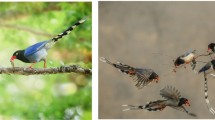Abstract
Autonomous vehicle guidance and trajectory planning is one of the key technologies in the autonomous control system for intelligent vehicles. Firstly, the target pursuit model for intelligent vehicles was established and described in this text. Then, the research work for global motion planning was carried out based on Stackelberg Differential Game Theory, and the global optimal solution was obtained by using the survival type differential game. Finally, to overcome errors, we use a polynomial method to achieve the smooth motion planning. So, based on Terminal Sliding Mode method, the Active Front Steering controller design was used to calculate the desired active wheel angle for intelligent vehicle path tracking. The simulation and experiment results demonstrate the feasibility and effectiveness of this method for intelligent vehicles’ path planning and tracking.














Similar content being viewed by others
References
Yilmaz NK et al (2008) Path planning of autonomous underwater vehicles for adaptive sampling using mixed integer linear programming. IEEE J Ocean Eng 33(4):522–537
Garcia MA et al (2009) Path planning for autonomous mobile robot navigation with ant colony optimization and fuzzy cost function evaluation. Appl Soft Comput 9(3):1102–1110
Xu C, Duan H, Liu F (2010) Chaotic artificial bee colony approach to uninhabited combat air vehicle (UCAV) path planning. Aerosp Sci Technol 14(8):535–541
Jaillet L, Cortés J, Siméon T (2010) Sampling-based path planning on configuration-space costmaps. IEEE Trans Robot 26(4):635–646
Kirillova S et al (2008) An NMA-guided path planning approach for computing large-amplitude conformational changes in proteins. Prot: Struct Funct Bioinform 70(1):131–143
Sud A et al (2008) Real-time path planning in dynamic virtual environments using multiagent navigation graphs. IEEE Trans Vis Comput Graph 14(3):526–538
Tsai C, Huang H, Chan C (2011) Parallel elite genetic algorithm and its application to global path planning for autonomous robot navigation. IEEE Trans Ind Electron 58(10):4813–4821
Roberge V, Tarbouchi M, Labonté G (2013) Comparison of parallel genetic algorithm and particle swarm optimization for real-time UAV path planning. IEEE Transact Indust Inform 9(1):132–141
Mahmoudian N, Geisbert J, Woolsey C (2010) Approximate analytical turning conditions for underwater gliders: implications for motion control and path planning. IEEE J Ocean Eng 35(1):131–143
Liu S, Sun D, Zhu C (2011) Coordinated motion planning for multiple mobile robots along designed paths with formation requirement. IEEE/ASME Transact Mechatron 16(6):1021–1031
Soulignac M (2011) Feasible and optimal path planning in strong current fields. IEEE Trans Robot 27(1):89–98
Gasparetto A et al (2012) Experimental validation and comparative analysis of optimal time-jerk algorithms for trajectory planning. Robot Comput Integr Manuf 28(2):164–181
Sun N et al (2012) A novel kinematic coupling-based trajectory planning method for overhead cranes. IEEE/ASME Transact Mechatron 17(1):166–173
Zhang R, Ge P, Zhou X, Jiang T, Wang R (2013) An Method for Vehicle-Flow Detection and Tracking in Real-Time Based on Gaussian Mixture Distribution. Adv Mech Eng 2013(861321):8
Glaser S et al (2010) Maneuver-based trajectory planning for highly autonomous vehicles on real road with traffic and driver interaction. IEEE Trans Intell Transp Syst 11(3):589–606
Anderson SJ et al (2010) An optimal-control-based framework for trajectory planning, threat assessment, and semi-autonomous control of passenger vehicles in hazard avoidance scenarios. Int J Veh Auton Syst 8(2):190–216
Capisani LM, Ferrara A (2012) Trajectory planning and second-order sliding mode motion/interaction control for robot manipulators in unknown environments. IEEE Trans Ind Electron 59(8):3189–3198
Duan H, Liu S, Wu J (2009) Novel intelligent water drops optimization approach to single UCAV smooth trajectory planning. Aerosp Sci Technol 13(8):442–449
Gasparetto A, Zanotto V (2008) A technique for time-jerk optimal planning of robot trajectories. Robot Comput Integr Manuf 24(3):415–426
Karaman S, Frazzoli E (2011) Sampling-based algorithms for optimal motion planning. Intern J Robot Res 30(7):846–894
Kress-Gazit H, Fainekos GE, Pappas GJ (2009) Temporal-logic-based reactive mission and motion planning. IEEE Trans Robot 25(6):1370–1381
Wen-xiao Z, Tong-hai J, Xiao L, Jun-lin Z, Rong-hui Z, Yan-en W (2014) Transmission of wireless sensor networks based on distributed multi-staging area check method. J Jilin Univ Eng Technol Ed 44(01):246–252
Kuwata Y et al (2009) Real-time motion planning with applications to autonomous urban driving. IEEE Trans Control Syst Technol 17(5):1105–1118
Likhachev M, Ferguson D (2009) Planning long dynamically feasible maneuvers for autonomous vehicles. Intern J Robot Res 28(8):933–945
Ghabcheloo R et al (2009) Coordinated path-following in the presence of communication losses and time delays. SIAM J Control Optim 48(1):234–265
Dolgov D et al (2010) Path planning for autonomous vehicles in unknown semi-structured environments. Intern J Robot Res 29(5):485–501
Nouyan S, Campo A, Dorigo M (2008) Path formation in a robot swarm. Swarm Intell 2(1):1–23
Feng Y, Ronghui Z, Lie G et al (2015) Trajectory planning and tracking control for autonomous lane change maneuver based on the cooperative vehicle infrastructure system. Expert Syst Appl 45(2015):5932–5946
Acknowledgments
This paper is supported by the Zhejiang Provincial Natural Science Foundation under Grant No.LY13E080010. The first author would like to appreciate Dr. Xuecai Yu and the reviewers for the valuable discussions to improve the quality and presentation of the paper.
Author information
Authors and Affiliations
Corresponding author
Ethics declarations
Conflict of Interests
The authors declare that there is no conflict of interests regarding the publication of this paper.
Rights and permissions
About this article
Cite this article
Wang, Hw., Yu, Xc., Song, Hb. et al. A Global Optimal Path Planning and Controller Design Algorithm for Intelligent Vehicles. Mobile Netw Appl 23, 1165–1178 (2018). https://doi.org/10.1007/s11036-016-0778-5
Published:
Issue Date:
DOI: https://doi.org/10.1007/s11036-016-0778-5




